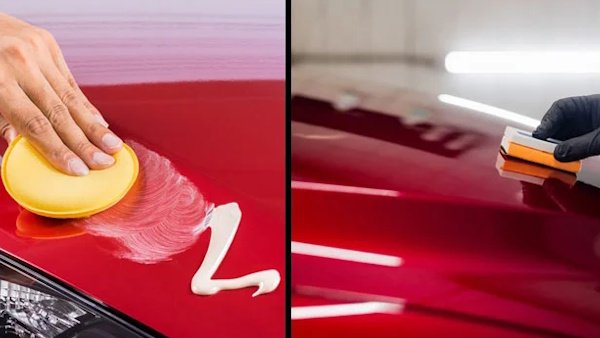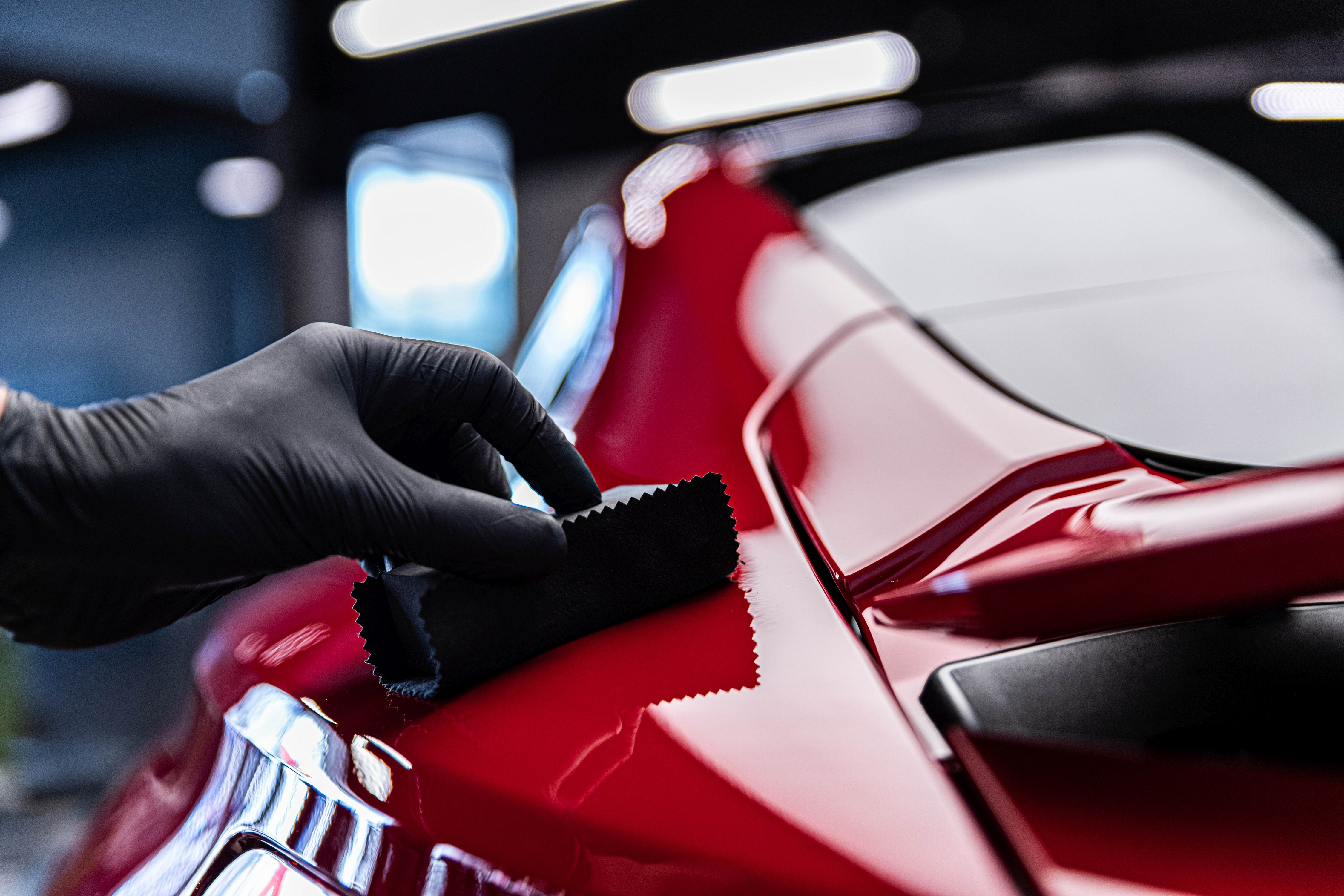Checking out the Science Behind Car Ceramic Coating and Its Safety Residences
The scientific research of car ceramic coating provides an interesting study in innovative vehicle protection. Made up mainly of silicon dioxide and polymers, these coverings create a robust bond with vehicle paint. This communication enhances durability versus environmental hazards while offering hydrophobic advantages. The details of just how these finishings work and their long-lasting advantages stay less understood. Ceramic Coating Newark. Unpacking these details reveals why ceramic coverings are coming to be a preferred choice for vehicle care
What Is Ceramic Coating?
Ceramic coating is a liquid polymer that chemically bonds to the surface area of a vehicle's paint. This sophisticated safety layer improves longevity and supplies remarkable resistance to environmental elements. Unlike conventional wax or sealers, which offer short-lived protection, ceramic finishes develop a durable guard that can stand up to extreme conditions such as UV rays, acidic contaminants, and extreme climate. When used correctly, the coating creates a hydrophobic surface area, creating water to grain and slide off, which assists in preserving the automobile's cleanliness. Additionally, it uses boosted gloss and depth to the paint, making the car show up more polished and vivid. The application procedure commonly involves comprehensive surface prep work, consisting of cleaning and polishing, to assure peak bonding. Consequently, ceramic coatings are ending up being increasingly prominent amongst car fanatics and those looking for to secure their financial investments, guaranteeing to preserve the car's aesthetic appeal while decreasing the frequency of maintenance.
The Make-up of Ceramic Coatings
The detailed solution of ceramic finishes mostly contains silicon dioxide (SiO2), which is originated from natural sources like quartz and sand. This vital part supplies the foundation for the coating's toughness and protective high qualities. In enhancement to SiO2, ceramic layers typically consist of numerous polymers and ingredients that enhance bond, adaptability, and resistance to environmental variables. These compounds work synergistically to produce a durable barrier versus pollutants such as dust, chemicals, and UV rays.Furthermore, some formulas integrate titanium dioxide (TiO2) or various other nanomaterials, which can increase the coating's hydrophobic homes, causing better water repellency. The exact structure can differ considerably among suppliers, impacting efficiency and longevity. Ultimately, the combination of these elements culminates in a protective layer that not only improves the aesthetic appeal of lorries yet also serves to prolong their life expectancy by securing the surface from prospective damages.
Just How Ceramic Coatings Job
Recognizing exactly how ceramic coatings function involves exploring their chemical structure, which adds to their protective high qualities. The application process is necessary for attaining ideal results, while longevity and toughness aspects identify the coating's effectiveness with time. Together, these components highlight the advantages and performance of ceramic finishings for lorry protection.
Chemical Structure Explained
While lots of car proprietors seek resilient defense for their lorries, the chemical composition of ceramic finishings plays a crucial function in their efficiency. These finishes largely include silicon dioxide (SiO2), which is stemmed from natural minerals. This compound develops a solid bond with the lorry's paint, developing a durable, protective layer. In addition, numerous ceramic layers include titanium dioxide (TiO2), boosting their hydrophobic residential properties and resistance to UV rays. The existence of polysiloxanes can better enhance adaptability and resilience. With each other, these aspects add to the coating's capability to fend off water, dirt, and contaminants, while likewise providing a high-gloss coating. Comprehending this chemical structure helps car proprietors value the robust defense used by ceramic finishes.
Application Refine Summary
Using ceramic finishes includes a precise procedure that guarantees suitable bonding and defense for the vehicle's surface area. Detailed More Bonuses cleaning and purification of the car's outside are executed to remove dirt, gunk, and previous waxes. This action validates that the surface area is complimentary from impurities that can impede bond. Following this, the paint is typically polished to enhance clarity and remove any flaws. As soon as prepared, the ceramic coating is used in tiny sections using an applicator pad, enabling consistent insurance coverage. The coating is after that entrusted to treat, creating a solid chemical bond with the surface area. Appropriate treating times and conditions are vital, as they confirm the coating achieves its optimum performance and safety high qualities.
Longevity and Resilience Elements
Ceramic layers are developed to give lasting defense with their advanced chemical structure, which develops a robust barrier versus ecological contaminants. The toughness of these coverings is influenced by aspects such as the thickness of the application, the top quality of the product, and the conditions under which the vehicle is exposed. Top notch ceramic coverings can last a number of years, resisting scrapes, UV rays, and chemical discolorations. Proper maintenance, consisting of regular cleaning and routine reapplication, can further enhance long life. Additionally, environmental variables like climate and direct exposure to contaminants can affect the life-span of the coating. On the whole, when used and maintained correctly, ceramic finishes use phenomenal toughness, making them a popular option for car enthusiasts looking for to protect their lorry's appearance.
Hydrophobic Qualities and Water Repellency
Hydrophobic properties are a trademark of quality car ceramic coatings, considerably boosting the lorry's surface performance. These finishes produce a molecular bond with the car's paint, leading to a surface area that fends off water successfully. When water enters contact with a ceramic-coated surface area, it beads up and rolls off, lessening the amount of fluid that remains on the paint. This behavior not only adds to an aesthetically pleasing look however likewise lowers the accumulation of contaminants such as dust, gunk, and road salts.The boosted water repellency leads to less complicated cleansing and maintenance, as less effort is needed to get rid of unwanted substances. Additionally, the hydrophobic nature of ceramic layers assists in stopping water spots, which can mar the coating of uncoated surfaces. On the whole, the consolidation of hydrophobic buildings in ceramic finishings plays a necessary function in preserving the car's beautiful look while streamlining maintenance.
Security Versus Scratches and UV Damage
Car ceramic finishes offer substantial protection versus scratches and UV damages. The scratch resistance system creates a sturdy layer that takes in impacts, while the UV securing benefits help maintain the lorry's paint stability with time. With each other, these attributes add to a longer-lasting and visually attractive surface.
Scrape Resistance Mechanism
Utilizing sophisticated technology, ceramic finishings supply a durable guard versus scratches and UV damages, improving the durability and look of vehicle surfaces. The scrape resistance system of these coatings is connected to their special molecular structure, which forms a long lasting bond with the automobile's paint. This bond creates a hard, protective layer that can soak up influences and withstand abrasions. Additionally, the smooth surface area of the coating decreases friction, making it tough for pollutants to stick and create scrapes. The chemical structure of ceramic coatings typically includes nanoparticles that strengthen the safety layer, more enhancing its durability. Automobiles treated with ceramic coatings display substantially boosted scrape resistance compared to standard wax or sealants, guaranteeing an excellent surface over time.
UV Shielding Conveniences
The protective qualities of ceramic layers prolong past scratch resistance to consist of considerable UV securing benefits. These coatings produce a durable barrier that mirrors damaging ultraviolet rays, safeguarding the automobile's paint and underlying materials. Extended direct exposure to UV radiation can result in fading, oxidation, and deterioration of the paint surface. By including ceramic finishings, lorry owners can properly alleviate these dangers, maintaining the aesthetic charm and integrity of their cars. In addition, the UV obstructing Your Domain Name properties add to improved long life, lowering the regularity of painting and maintenance. Inevitably, the assimilation of ceramic layers supplies a detailed service for shielding lorries from the destructive results of sunlight direct exposure, guaranteeing a sustained, lively look over time.
The Long life and Maintenance of Ceramic Coatings

Regularly Asked Concerns
Can Ceramic Coating Be Applied to Any Kind Of Lorry?
Ceramic coating can be put on different kinds of vehicles, including autos, vehicles, and motorcycles. Surface prep work and compatibility with details products are crucial for ideal attachment and performance of the coating.
Just How Much Does Ceramic Coating Normally Cost?
Ceramic coating typically sets you back between $500 and $2,000, relying on aspects such as car dimension, coating top quality, and expert application. The investment can offer lasting security and enhance the car's appearance with time.

Is Expert Application Needed for Finest Results?
The need of specialist application commonly depends upon preferred outcomes. Experts typically assure appropriate surface preparation and application strategies, bring about excellent bonding and durability of the coating, which may be challenging for unskilled people to achieve.
Can Ceramic Coatings Be Removed or Fixed?
Ceramic layers can be removed or repaired, though the process may require particular solvents or methods - Ceramic Coating Newark. Correct elimination is important to stay clear of damages to the underlying surface area, stressing the relevance of expert support for perfect outcomes
Just How Does Ceramic Coating Compare to Conventional Wax?
The contrast in between ceramic coating and conventional wax reveals that ceramic finishes provide remarkable sturdiness, improved protection against ecological pollutants, and longer-lasting sparkle, while wax requires a lot more constant application and provides much less general resistance to damage.